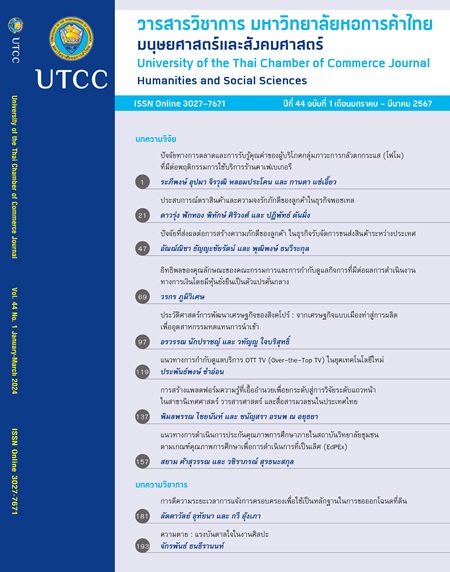Marketing Factors and Consumer’s Value Perception Affecting the Fear of Missing Out (FOMO) on the Behavior of Using Café Bakery Services
Main Article Content
Abstract
The objective of this research is to study the factors and behaviours related to the actual usage of bakery cafe services by the FOMO group. The research includes the 7Ps of Marketing, social perception factors, and emotional perception factors. It employed a quantitative research approach, specifically survey research, using a questionnaire administered to a sample of 400 customers of bakery cafes in Bangkok. The study applied statistical methodologies such as percentages, means, standard deviations,and Factor Analysis which includes Principal Component Analysis (PCA), and Varimax method to analyse the data. The research findings indicate the rank of important factors in the 7Ps of marketing for the FOMO group: 1) In-store service - cheerful and friendly employees who are genuine 2) Store-produced video clips providing product knowledge 3) Store located in a modern and trendy commercial center 4) Store offering freebies or giveaways and 5) Products being priced lower than other
The most influential factors in the perception of social value for the FOMO (Fear of Missing Out) group are being praised and celebrated in the online community for consuming products and services at coffee bakery shops. Additionally, the most significant factor in the emotional value perception for the FOMO group is feeling the utmost pleasure when consuming products and services at coffee bakery shops.
These research findings can be used as guidance for developing products and services to meet the needs of the FOMO group, as well as for creating marketing strategies to keep up with the current era.
Article Details

This work is licensed under a Creative Commons Attribution-NonCommercial-NoDerivatives 4.0 International License.
ลิขสิทธิ์ของบทความ
ผลงานที่ได้รับการตีพิมพ์ถือเป็นลิขสิทธิ์ของมหาวิทยาลัยหอการค้าไทย ห้ามมิให้นำเนื้อหา ทัศนะ หรือข้อคิดเห็นใด ๆ ของผลงานไปทำซ้ำ ดัดแปลง หรือเผยแพร่ ไม่ว่าทั้งหมดหรือบางส่วนโดยไม่ได้รับอนุญาตเป็นลายลักษณ์อักษรจากมหาวิทยาลัยหอการค้าไทยก่อน
References
จงกลนี บุญณะ, จิตสุภา จึงเจริญนิรชร, และอริสสา สะอาดนัก. (2558). พฤติกรรมการใช้โทรศัพท์มือถือที่ส่งผลต่อโรคโมโนโฟเบียที่ส่งผลต่อประชาชนในเขตกรุงเทพมหานคร. ใน การประชุมวิชาการประจำปี สังคมศาสตร์ มนุษยศาสตร์ และศึกษาศาสตร์ ครั้งที่ 9 วันที่ 26-27 มีนาคม พ.ศ. 2558 หัวข้อ “ปฎิรูปประเทศไทย” ณ โรงแรมรอยัลริเวอร์ กรุงเทพมหานคร (น.43-53). กรุงเทพฯ: มหาวิทยาลัยมหิดล
จุฑาทิพย์ ทองศรี. (2560). การให้ความสำคัญและการรับรู้กลยุทธ์การตลาดบริการโดยใช้กลยุทธ์ Q-MARKของลูกค้าร้านเบเกอรี่คาเฟ่ในจังหวัดภูเก็ต (วิทยานิพนธ์ปริญญามหาบัณฑิต, มหาวิทยาลัยกรุงเทพ). สืบค้นจาก http://dspace.bu.ac.th/jspui/handle/123456789/3799
ญาณิน สุขเสวต, และกัตติมาส ลีลาสถาพรกิจ. (2558). ปัจจัยที่มีผลต่อการตัดสินใจเลือกใช้บริการร้าน เบเกอรีของผู้บริโภคในบางเขน กรุงเทพมหานคร.สืบค้นจาก https://repository.rmutp.ac.th/bitstream/handle/123456789/2622/HEC_61_35.pdf?sequence=1&isAllowed=y
โต๊ะข่าวไอที ดิจิทัล. (2565, 13 กุมภาพันธ์). เปิดสถิติใช้ "ดิจิทัล" ทั่วโลก "ไทย" ติดอันดับโลกเพียบ!!. กรุงเทพธุรกิจ. สืบค้นจาก https://www.bangkokbiznews.com/tech/988061
นภวรรณ คณานุรักษ์. (2556). พฤติกรรมผู้บริโภค. กรุงเทพฯ: ซีวีแอลการพิมพ์.
บุญชม ศรีสะอาด. (2556). วิธีการทางสถิติสำหรับงานการวิจัย เล่ม 1 (พิมพ์ครั้งที่ 5). กรุงเทพฯ: สุวีริยาสาสน์.
พัฒยา กุณโฮง. (2558). ส่วนประสมทางด้านการตลาดบริการ (7Ps) ต่อการตัดสินใจซื้อผลิตภัณฑ์อาหารแช่แข็งยี่ห้อ 7 Fresh. กรุงเทพฯ: สถาบันการจัดการปัญญาภิวัฒน์.
พิรานันท์ ใหมอ่อน. (2560). การศึกษากลยุทธ์การดำเนินธุรกิจร้านขนมหวาน: กรณีศึกษาร้านอาฟเตอร์ ยู (After You) (วิทยานิพนธ์ปริญญามหาบัณฑิต, มหาวิทยาลัยธรรมศาสตร์). doi: 10.14457/TU.the.2017.598
FoodStory. (2562, 19 พฤษภาคม). สำรวจธุรกิจร้านขนมหวาน และแนวทางการดำเนินกิจการ [บล็อก]. สืบค้นจาก https://www.foodstory.co/blog/sweetbar
วาว แฟคเตอร์. (2564). รายงานประจำปี 2563 บริษัท วาว แฟคเตอร์ จำกัด (มหาชน). สืบค้นจาก https://market.sec.or.th/public/idisc/Download?FILEID=dat/f56/F0753T21.zip
สำนักงานสถิติแห่งชาติ. (2563). รายงานสถิติรายปีประเทศไทย 2563. สืบค้นจาก http://service.nso.go.th/nso/nsopublish/pubs/e-book/SYB-2563/files/assets/basic- html/index.html#1
สิทธินันท์ พลวิสุทธิ์ศักดิ์. (2562, 21 พฤศจิกายน). Digital marketing trend 2023: เทรนด์การตลาดออนไลน์ปี 2023 ที่สรุปมาให้แล้ว!. [บล็อก]. สืบค้นจาก https://contentshifu.com/blog/digital-marketing-trends
สุชญา อาภาภัทร. (2559). ปัจจัยที่มีอิทธิพลต่อการตัดสินใจซื้อเบเกอรี่แบบ Take Away ของกลุ่มคนทำงานในเขตกรุงเทพมหานครและปริมณฑล (วิทยานิพนธ์ปริญญามหาบัณฑิต, มหาวิทยาลัยธรรมศาสตร์). doi: 10.14457/TU.the.2016.57
admin. (2562, 3 พฤษภาคม). ตกหนักที่แบรนด์ เมื่อผู้บริโภคมีหลายโมเมนต์ เทรนด์ FOMO ยังแรง แต่ JOMO ก็กำลังมา. Positioning Online. สืบค้นจาก https://positioningmag.com/1227809
Armstrong, G., & Kotler, P. (2014). Marketing an introduction (12th ed). Upper Saddle River, NJ: Pearson Prentice Hall.
Chuah, H. W., Marimuthu, M., & Ramayah, T. (2014). The effect of perceived value on the loyalty of generation Y mobile internet subscribers: A proposed conceptual framework. Procedia - Social and Behavioral Sciences, 130, 532-541. doi: 10.1016/J.SBSPRO.2014.04.062
Elhai, J. D., Levine, J. C., Dvorak, R. D., & Hall, B. (2016). Fear of missing out, need for touch, anxiety and depression are related to problematic smartphone use. Computers in Human Behavior, 63, 509–516. doi: 10.1016/j.chb.2016.05.079
Etzel, M. J., Walker, B. J., & Stanton, W. J. (2017). Marketing (14th ed.). Boston, MA: McGraw – Hill.
Foxall, G. R., & Sigurdsson, V. (2013). Consumer behavior analysis: Behavioral economics meets the marketplace. Psychological Record, 63(2), 231-238. doi: 10.11133/j.tpr.2013.63.2.001
Herman, D. (2000). Introducing short-term brands: A new branding tool for a new consumer
reality. Journal of Brand Management, 7(5), 330-340. doi: 10.1057/bm.2000.23
Kotler, P., & Keller, K. (2013). Marketing management (14th ed). Upper Saddle River, NJ: Pearson Education.
Przybylski, A. K., Murayama, K., DeHaan, C. R., & Gladwell, V. (2013). Motivational, emotional, and behavioral correlates of fear of missing out. Computers in Human Behavior, 29, 1841–1848. doi:10.1016/j.chb.2013.02.014
Schiffman, L. G., & Kanuk, L. L. (2007). Consumer behavior (9 th ed.). Upper Saddle River, NJ: Prentice Hall.
Schiffman, L. G, & Wisenblit, J. (2015). Consumer behavior (11 th ed.). Boston, MA: Pearson Education.
Sweeney, J. C., & Soutar, G. N. (2001). Consumer perceived value: The development of multiple item scale. Journal of Retailing, 77(2), 203-220. doi:10.1016/S0022-4359(01)00041-0
Van Strien, T., Frijters, J., Bergers, G., Defares, P. (1986). The Dutch eating behavior questionnaire (DEBQ) for assessment of restrained, emotional, and external eating behavior. International Journal of Eat Disorders, 5(2), 295-315. doi: 10.1002/1098108X(198602)5:2<295::AID-EAT2260050209>3.0.CO;2-T
Wang, Y. (2006). A cross-cultural study of consumer attitudes and emotional responses of apparel purchase behavior (doctoral dissertation, The Florida State University). Retrieved from http://purl.flvc.org/fsu/fd/FSU_migr_etd-1256


